Note: This was originally published in The Armenian Weekly.
There was a time when there were no
cell phones, internet or social media, which make communication so easy
today. There were telephones (we call them landlines today), and each
house had one phone number and one phone that everyone used. Long
distance calls were a luxury most folks only used when really good or
really bad news had to be communicated, and even then, the calls were
brief.
This era began around the 1930s and
40s when most people got their first home telephones. It ended between
2004, when Facebook launched, and 2007, which marked the debut of the
first iPhone. Interpersonal communication also took a leap forward after
1984 when the U.S. deregulated phone services. Soon after, service
providers started offering unlimited long distance service.
Before then, how did people know when
friends and acquaintances had weddings, births, graduations and deaths
in their family? They sent letters and telegrams and posted such news in
newspapers for their communities. The Hairenik Weekly served that role for its subscribers from its founding and continued to do so when it was renamed The Armenian Weekly.
The first generation of Armenians born in this country started to
graduate from high school and college, get married and have children
during the first 25 years of The Hairenik Weekly.
With the founding of the AYF,
Armenian youth got to be lifelong friends with Armenians across the
country. They would meet and bond at national events like the annual
convention and AYF Olympics and various regional events like AYF Bowling.
This generation wanted to keep in touch and stay aware of the comings
and goings of their friends and acquaintances. After graduating from
high school and college, they began writing for the Weekly and were given columns to report on local events of note. The heyday of this phenomenon seems to have been the 1950s.
 The
longest-running of these columns were not written by AYFers but set the
standard for all that followed. One was called “The Bostonian: Viewing
the Hub of the Universe.” It is not clear who wrote this column as it
had no byline. Perhaps it was the long-serving Weekly editor
James Mandalian or his successor James Tashjian. Another was “This and
That from New York” by Levon Keshishian. I believe Keshishian’s column,
spanning from the 1940s to at least the 1970s, had the longest run of
any column in the Weekly’s
history. The first two regional columns covered news from the two most
vibrant centers of Armenian life at the time. Let’s look at some of
these columns from five issues from the years 1954-56.
The
longest-running of these columns were not written by AYFers but set the
standard for all that followed. One was called “The Bostonian: Viewing
the Hub of the Universe.” It is not clear who wrote this column as it
had no byline. Perhaps it was the long-serving Weekly editor
James Mandalian or his successor James Tashjian. Another was “This and
That from New York” by Levon Keshishian. I believe Keshishian’s column,
spanning from the 1940s to at least the 1970s, had the longest run of
any column in the Weekly’s
history. The first two regional columns covered news from the two most
vibrant centers of Armenian life at the time. Let’s look at some of
these columns from five issues from the years 1954-56.

“As the nation goes, so does Maine,” written by Anthony Mezoian, was published in the September 30, 1955 issue of the Weekly.
There were Armenian communities in Maine and New Hampshire, a part of
our history that is barely known or remembered these days. The first
paragraph announced the marriage of my father’s first cousin. Here are
two excerpts:
Pauline Helenian
[actually Kelenian] of Rye, New Hampshire and Airman Martin Quirk were
recently married. He is stationed at Lockbourne Air Base, Columbus,
Ohio… Ray and Alice Mougalian recently entertained the famed movie stars
Betty [Bette] Davis and her husband Gary Merrill. Twelve attended the
cocktail party and all Armenian “feed” which consisted of everything
from shish-kebab to bourmah.
I would have loved to see a quote
from Bette Davis and a group photo of this event, but none of the
columns I read included photos.

From the Midwest, there was a column “On Wisconsin,” by Var Bagdasarian, which opened with the famed Drum Corp from Racine.
Imagine going to a bake
sale and being able to buy paghlava, kata, lahmahjou and all the other
wonderful Armenian delicacies. That is just what happened at the Gas and
Electric Co., of Racine on Friday, August 14. The Drum Corps decided to
repeat the Bake Sale idea, which was such a tremendous success, last
year. They were equally fortunate this time too. The people just “ate
it up.” The food was donated by the Drum Corps parents and friends to
help finance the trip to Washington D.C. Pretty nice of those women,
wouldn’t you say — to take time out of their household duties for this
project? The proceeds were all clear profit, and must have been high
because our Corps DID go to the Olympics. Oh, what a time they had, too.
Hope you got to see them.
It would be great if someone would
write the story of the Racine Drum Corps. Maybe there already is one in
the archives just waiting to be rediscovered.

Next up is the “West Coast Wire” by
none other than Richard Hovannisian. While this was before he became an
international spokesman for Armenians, we see a hint of what was to come
from this great Armenian.
We had the great honor
and privilege of visiting Unger Simon Vratzian for a couple of hours
while he was in San Francisco visiting at the Karageozian home. It is
difficult to explain the awe and pride of being in the presence of such a
great man — a man who was an integral part of the Independent Armenian
Republic serving as prime-minister. He was instrumental in the February
18 revolt against communism. His wealth of knowledge and wisdom can be
found in no history book. He lives with the living hope and
determination that Armenia will again be free. It is the duty of every
Armenian youth to strive to make this living hope a living realization.
The same words could be used to
describe Professor Hovannisian. He most definitely was a “wealth of
knowledge and wisdom” and actually got to see a free and independent
Armenia.
The next two columns are related. First, from “The Bostonian”:
Had the distinct pleasure
of meeting Mr. and Mrs. Mitchell and Rose Kehetian, and Mitch’s dad
Kaspar, during their recent visit to Boston, and it was most refreshing
to chat with such a wonderful family group devoted so thoroughly to the
cause of Armenian liberation. Though they have come through a period in
which dear members of their families have passed away, the closely-knit
three have retained their natural ebullience.

This same issue of the Weekly contained
Mitchell Kehetian’s column, “Motor City News.” Kehetian had an
illustrious career in Detroit. He was a reporter for the Detroit Times when he wrote this column for the Weekly then an editor at the Macomb Daily.
Mr. and Mrs. Zakar
Manoogian announced the marriage of their daughter, Stella, to Jack
Tian, son of Mrs. Anoosh Tufenkjian. The ceremony, performed by the Rev.
S. Papakhian, took place at the St. Sarkis Armenian Apostolic Church,
after which a reception was held. Stella is an active member of the
Detroit Moorad-Zavarian chapter. The couple honeymooned by taking a tour
through Michigan. The newlyweds are making their home at 4055 Ida.,
Detroit.
It is not unusual that Kehetian wrote
one column and was mentioned in another. As another point of
connectivity, Ned Apigian just penned a wonderful article about Jack
(Hagop) Tian and his brother Haigus, “A story of two Detroit brothers in war,” published on June 29, 2024.

We go back to the East Coast for “The
Philadelphia Story” by Iris Pilbosian. In this column, she shares this
tidbit about Dick Keshgegian, who was a pillar of the Philadelphia
community.
A hearty hello and
welcome home to Dickie Keshgegian, just recently discharged by Uncle
Sam, after spending many months in Korea. We can’t help mentioning that
beautiful, new Oldsmobile, a “small” gift from mom and dad Keshgegian.
Seriously, though, Dick, the Phila. “Sebouh” chapter extends a sincere
“Welcome Home” to one of its favorite members.

The last stop in this September 30, 1954 issue of the Weekly is
Washington, D.C. Anne Atanosian wrote this “DC Dateline” column about
Dr. Sarkis Balassanian. He was from Argentina and attended the World
Congress of Cardiologists in the nation’s capital on September 10-19,
1954. In describing Dr. Balassanian’s path to becoming an eminent
cardiologist, she spoke to the spirit of the survivor generation and
their children.
Reaching Argentina as a
young boy with his parents, young Sarkis worked very hard to achieve his
education, an education which found his yearnings leaning toward
medicine. As any one of us who have listened to the stories of the early
struggles of our refugee parents, we can appreciate that it is only
through the most diligent kind of self deprivation that any progress can
be made in a strange land. But this progress was made through
perseverance which is so common a trait among our people.

There were more examples of local reporting in the December 29, 1955 Hairenik Weekly,
including two columns from Chicago. The first was the “Windy City Wire”
by Diane Nazarian. Here are three updates from her column.
On November 25 little
Becky Jan Sahagian celebrated her first birthday. Becky is the lovely
daughter of John and Lucille Sahagian.
On December 5 the Museum of Science
and Industry presented a program featuring the Armenian Christmas
celebration. AYFers in the presentation were June Der Matoian, Charles
Serejian, Violet Allikian, and Ara Bedrosian.
December 10 was the day of our
colossal Hye Bar at the Sheridan Plaza Hotel. The Arziv [Ardziv] Band
from Detroit was at its best and the crowd loved them! Everyone danced
and had a wonderful time until the wee hours.
My connections to people mentioned in
these articles continue to surprise me, even though I know our
community is small and tight knit. We got to know John and Lucille in
1990, the year we relocated to Connecticut. They lived in Fairfield, and
we all were members of the Armenian Church of the Holy Ascension in
Trumbull. I also grew up listening to the Ardziv Band. When I began to
play, we always invited Simon Javizian, the leader of Ardziv, to join us
on clarinet and sing a song or two. One of my ouds used to belong to
their talented oud player, Harry Bakaian. You can hear him playing it
at the beginning of Kaleh Kaleh from their Traveling for Kef album.

Hazel Tatson in “The Voice of the Chicago” reported on the Chicago chapter wanting to start a local newspaper:
The Ararat AYF Chapter,
recognizing this need, set forth to work out plans for organizing a
paper that would fill the requirements of a small Armenian community.
The AYF felt that such a newspaper would not only serve as a source of
news, but it would better the youth and the parental organizations, it
would bring the voice of the church closer to the community, and mainly
it would support, preserve, and maintain the Armenian culture.
What a wonderful and noble idea. I wonder if the paper ever came to fruition. It would be interesting to review a few copies.
Of course, there was a column from
Providence. The “Providence Press” was written by Rosalie Kolligian. She
announced the birth of her nephew in this particular column:
Mr. and Mrs. John
Varadian of Providence are proud parents of a new baby, their second
son. He was born on December 9, 1955. Mrs. Varadian is the former Sylvia
Kolligian of Providence. Congratulations Sis and Jay.
The name of the newborn was not
mentioned in the article. I asked Mike Varadian, who related that it was
his cousin Stephen Jay. Sadly, Stephan passed away on September 20,
2000, a few months shy of his 50th birthday. He had battled brain cancer
for 22 months. His obituary was in the October 7, 2000 Armenian Weekly.

There were three examples in the September 29, 1955 Weekly of
regional columns. Levon Keshishian’s “This and That from New York”
talked about the passing of two noted Armenians: Dr. K. Seropian in New
York and Dicran Bagdassarian in Tehran. Keshishian wrote about how he
and his friend Dr. Seropian would discuss “Armenian politics, literature
and international affairs” as well as their shared passion for stamp
collecting. He had this to say about Bagdassarian:
I had read his articles
and books and had become an admirer of this revolutionary of this
generation. He was a sincere man and very impressive. There are men you
admire before you see them. Many disappoint you when you meet them,
somehow you say to yourself, “I wish I had not come to know the man.”
Dicran Bagdassarian was not of these, you liked him more.
There were also two columns from
Wisconsin in the 1950s. The second of these was “Racine News” by Corrine
DerGarabedian. In one column was this tidbit:
At a recent Chicago
meeting for members, two from Chicago and two from Racine volunteered to
go to Waukegan and see how their chapter is getting along. The Racine
representatives, Mary Madasian and Sonia Gelenian, reported that
everything is running smoothly. We wish the Waukegan chapter all the
luck in the future.

On the other side of the state of New York was Alice Arutunjian who wrote a column, “News and Views From Niagara Falls.”
I am proud to announce
that young Ned Apigian, 17, a Shant Committee member was awarded a $20
honorable mention award for a drawing in the mechanical drawing division
in the Ford Motor Co’s. ninth annual industrial arts awards
competition. Ned is working this summer and will start his last year at
the Trott Vocational School in Niagara Falls.
We now have a beautiful bow of
connections between the “The Bostonian” mentioning Mitchell Kehetian,
Mitchell Kehetian’s “Motor City News” mentioning Jack Tian, Ned
Apigian’s recent article about Jack Tian and this mention of Ned in the
“News and Views From Niagara Falls.”

Lastly, in the May 10, 1955 Weekly,
I came across “Nutmeg Newsettes: Connecticut Capers” by Mary Kaprealian
in which she mourns the loss of a beloved community member, presumably a
genocide survivor.
It is with a heart full
of sorrow that we start this report on activities and events in
Connecticut. During the interim between this and our first column, the
Hartford-New Britain area suffered a tragic loss at the sudden death of
Mrs. Rose (Kalajian) Boornazian on April 23 at the age of 52. Mrs.
Boornazian passed away suddenly as a result of a cerebral hemorrhage, as
closely as we can ascertain. Her loss is mourned… not only by her
family… but by both communities, as well. Our own friendship with her
stems from the writer’s early childhood.
It would take an issue-by-issue
investigation to learn when these columns began and ended and how
frequently they ran. Clearly, they were popular in the 1950s. The
artwork and masthead for each of these columns were unique. Some were
clearly hand drawn and all of them used fonts we don’t see much of these
days. These columns were, from my perspective, the social media of that
era and another example of the treasure trove that is the Hairenik Archives.





























